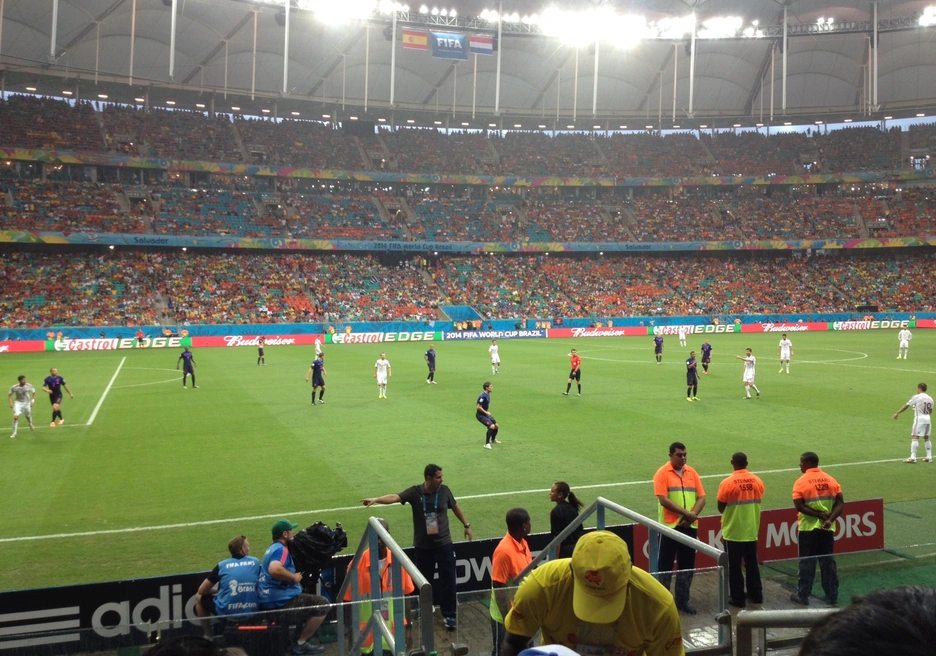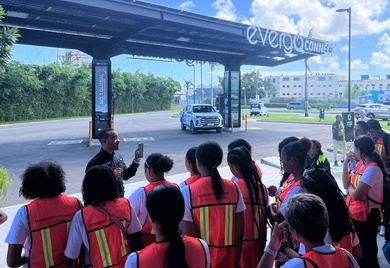What is the World Cup's Carbon Footprint?

[caption id="attachment_1138" align="alignleft" width="300"] Spain versus Netherlands[/caption]
Spain versus Netherlands[/caption]
The opportunity to watch the World Cup in Brazil has been an unforgettable experience. In addition to the games themselves, I’ve also been able to explore Salvador and soak in all its sights and sounds. What an amazing city! While there have been riots in other cities, the locals I’ve spoken to have been extremely welcoming to the hundreds of thousands of foreigners visiting for the World Cup. With everyone wearing their national team’s jerseys – the red of Spain and Switzerland, bright Australian yellow, blazing orange for Holland – it feels like a global party.
All the different jerseys and languages got me thinking: how much energy did it take for all these people to come Brazil? An estimated 500,000 people will travel to Brazil for the World Cup, flying and driving from thousands of miles away. Personally, I flew from Washington, DC, to Miami to Sao Paulo to Salvador; the round trip will be over 12,000 miles. Given that each passenger mile flown results in about 0.5 pounds of CO2 emitted, I’m personally responsible for 2.9 tons of greenhouse gas emissions! And that leaves out any extra food I eat, the taxis I take, air-conditioning I cool off in, among other impacts. All told, the World Cup will result in about 2.7 million tons of greenhouse gas emissions – equivalent to the annual emissions of more than 500,000 cars.
[caption id="attachment_1139" align="alignright" width="300"] Jordi Alba throws the ball in[/caption]
Jordi Alba throws the ball in[/caption]
Recognizing this impact, FIFA has done a thorough breakdown of the direct and indirect emissions related to the World Cup. The estimate leaves out some related emissions, such as construction of stadia and other infrastructure for the World Cup but attempts to capture the impact from most other sources. The most remarkable part of the study is that 97.9% of the 2.7 million tons come from fans’ travel.
Although FIFA is technically a non-profit organization, it is hugely profitable, with over $4 billion in revenues and $600 million in net revenues between 2007 and 2010. As such, it has a business interest in addressing the environmental impact of its signature event. In order to lessen the impact of the World Cup, FIFA has an emissions offset program, which will offset the emissions from about 50,000 fans – approximately 250,000 tons. The offset projects will reduce carbon emissions in a variety of ways. Some, by reducing emissions from deforestation, will invest in improved forest management and agricultural practices. Others, by reducing fossil fuel use, will increase renewable energy generation.
In the ideal world, the World Cup wouldn’t result in any greenhouse gas emissions. But for now, offsetting is one way that businesses and people can lessen that impact. In the midst of all the elation of the World Cup, it’s a sobering thought.
LIKE WHAT YOU JUST READ?
Subscribe to our mailing list to stay informed on the latest IDB Invest news, blog posts, upcoming events, and to learn more about specific areas of interest.
Subscribe



